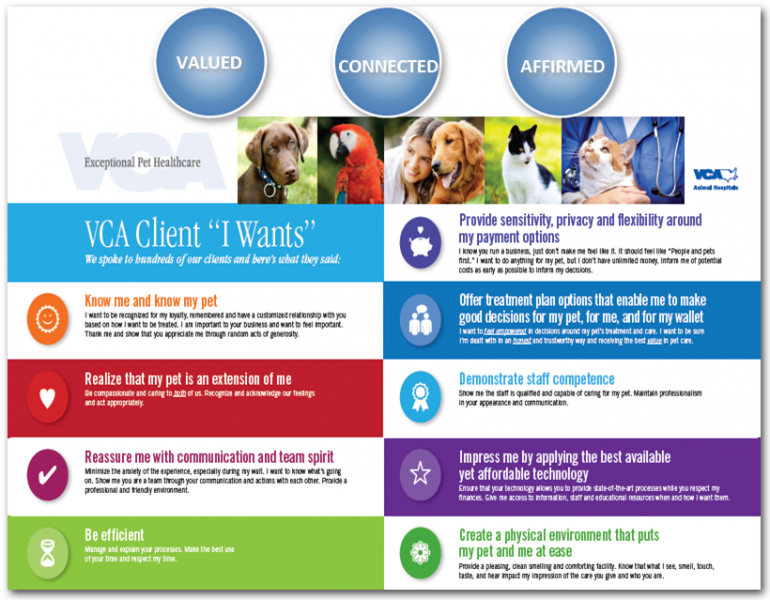Q&A With Kathleen Cattrall and Aaron Frazier Of VCA Animal Hospitals
Earlier this year, I spoke with Kathleen Cattrall, interim chief experience officer at VCA Animal Hospitals about the company’s customer experience transformation efforts. VCA is a publicly traded company (fittingly, its NASDAQ ticker symbol is WOOF) that owns and operates more than 600 pet hospitals in the US and Canada. Its work to create more customer-centric hiring processes features in my latest report, "How To Hire And Onboard Customer-Centric Employees."
Kathleen and her colleague Aaron Frazier were gracious enough to answer a few more questions about their progress in building a more customer-centric culture and what they’ve learned about creating great pet-owner experiences. Here are some of their insights.
Q. How did VCA know it needed to improve customer experience? Was there a “burning platform,” or did someone senior at the organization decide it was time to make a change?
A. Art Antin, co-founder and COO, was the real visionary here. VCA was approaching its 25th anniversary, and Art was frustrated with clients visiting less frequently. Our customer retention rate was lower than VCA wanted to see. Complaints were escalating, and they all pointed to a poor customer experience. Art said, “We’ve spent 25 years becoming the leader in veterinary health services. We’ve accomplished more than any other company in that regard. We need to focus the next 25 months on improving our customers’ experiences with us.”
Q. How did you determine where to start in terms of improving customer experience?
A. There’s so much CX noise out there. Everyone has a different perspective and opinion on what CX means and what you should do. We were fortunate that Kathleen had done this before at Time Warner Cable. She was able to guide us quickly through the gauntlet. The place to start: with customers. There was so much we didn’t know about them in this regard. For example, we didn’t have enough information on what our customers want in a relationship with their vet. We didn’t know how they currently feel when they go to the vet and what experiences make them feel one way or another. We didn’t understand the journey our customers are on with their pet. Spending four weeks on the road doing nothing but talking to customers and having them map their journey gave us insight into what we needed to do immediately. That was a rapid design approach!
Q. When did you first sense that the transformation was really picking up speed? Was there a moment or a conversation that gave you confidence you were on the right track?
A. We had two indications that we were making really big breakthroughs. One was when a veterinarian stopped me in the hall and said, “I’ve been practicing veterinary medicine for 40 years and I thought I was doing it all right. You have caused me to go back into my practice and reevaluate everything we’re doing.”
The second was when we were running a workshop for about 60 vets and hospital managers. We were having some fun describing how Starbucks creates its customer experience when someone in the group raised an objection. “But how can you compare us to Starbucks? We practice medicine?” Another member of the audience answered, “If I can’t be better than a cup coffee, then what good am I?”
Q. What would you say have been your biggest accomplishments so far in changing the culture at VCA?
A.
- Incorporation of CX nomenclature into every corner of the company — we’re seeing every department, every hospital, using the language of CX in their daily work. For example, when a client complaint or compliment is surfaced, we see staff identifying the specific actions that took place to cause the client to feel either positive or negative about the experience. Staff will refer to one of the nine customer “I Wants” we identified in our customer research and determine whether we delivered on that “I Want” or not.
- We also see the field staff taking ownership, making the CX effort its own and being creative about how to use the concepts in meaningful ways. For example, during the inaugural World CX Day on October 1st, we had a majority of our hospitals embrace the spirit of the day by creating their own celebrations.
- On the topic of ownership, we see most of the leadership has included a CX topic on the meeting agendas, ensuring that CX remains top of mind.

Q. What’s next for your CX transformation efforts at VCA?
A. We’re continuing to embed CX within job descriptions/the company handbook and expand our efforts to define who we are as a company . . . our brand.